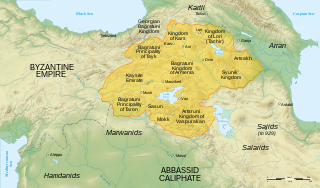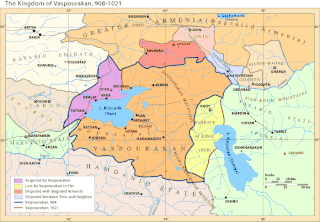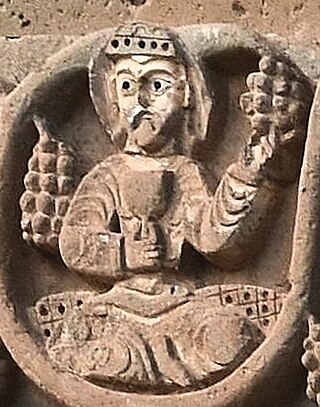Related Research Articles

The Kingdom of the Iberians was a medieval Georgian monarchy under the Bagrationi dynasty which emerged circa 888 AD, succeeding the Principality of Iberia, in historical region of Tao-Klarjeti, or upper Iberia in north-eastern Turkey as well parts of modern southwestern Georgia, that stretched from the Iberian gates in the south and to the Lesser Caucasus in the north.

Smbat I, sometimes Smbat A Martyr was the second king of the medieval Kingdom of Armenia of the Bagratuni dynasty, and son of Ashot I. He is the father of Ashot II and Abas I.
Ashot I was a king of Armenia who oversaw the beginning of Armenia's second golden age. He was the son of Smbat VIII the Confessor and was a member of the Bagratuni dynasty.

Yusuf ibn Abi'l Saj was the Sajid amir of Azerbaijan from 901 until his death. He was the son of Abi'l-Saj Devdad.
Medieval Armenia refers to the history of Armenia during the Middle Ages. It follows Ancient Armenia and covers a period of approximately eight centuries, beginning with the Muslim conquest of Armenia in the 7th century. Key events during this period includes the rebirth of an Armenian Kingdom under the Bagratid dynasty, followed by the arrival of the Seljuk Turks. During this period, a portion of the Armenian people migrate to Cilicia to seek refuge from invasions, while the remnants in Eastern Armenia see the establishment of Zakarid Armenia under the Kingdom of Georgia. This period also marks the emergence of the royal dynasty in Artsakh.
Ashot IV Bagratuni, better known as Ashot Msaker, reputedly for his refusal to refrain from eating meat during Lent, was an Armenian prince from the Bagratid family. A fugitive from the failed uprising in 775 against Arab rule in Armenia, where his father was killed, over the next decades he gradually expanded his domains and established a predominant role for himself in the country's affairs, becoming recognized by the Abbasid Caliphate as presiding prince of Armenia from 806 until his death in 826.

Bagratid Armenia was an independent Armenian state established by Ashot I of the Bagratuni dynasty in the early 880s following nearly two centuries of foreign domination of Greater Armenia under Arab Umayyad and Abbasid rule. With each of the two contemporary powers in the region—the Abbasids and Byzantines—too preoccupied to concentrate their forces on subjugating the region, and with the dissipation of several of the Armenian nakharar noble families, Ashot succeeded in asserting himself as the leading figure of a movement to dislodge the Arabs from Armenia.

The Kaysite dynasty was a Muslim Arab dynasty that ruled an emirate centered in Manzikert from c. 860 until 964. Their state was the most powerful Arab amirate in Armenia after the collapse of the ostikanate of Arminiya in the late 9th century.

The Kingdom of Vaspurakan was a medieval Armenian kingdom centered on Lake Van, located in what is now eastern Turkey and northwestern Iran. It was named after Vaspurakan, a province of historic Greater Armenia. Ruled by the Artsruni dynasty, it competed and cooperated with the Bagratuni-ruled Kingdom of Armenia for a little over a century until its last king ceded the kingdom to the Byzantine Empire in 1021.

Gagik I Artsruni was an Armenian noble of the Artsruni dynasty who ruled over Vaspurakan in southern Armenia, first as prince of northwestern Vaspurakan and after that until his death as King of Vaspurakan, also claiming the title of King of Armenia.
Derenik-Ashot Artsruni was the second King of Vaspurakan, from the Artsruni dynasty, succeeding his father, Gagik I, on the latter's death. He died childless in 958/959 and was succeeded by his younger brother Abusahl-Hamazasp.
Abusahl-Hamazasp Artsruni was the third King of Vaspurakan, from the Artsruni dynasty, succeeding his childless elder brother, Derenik-Ashot, on the latter's death. On his death in 968/969, his kingdom was divided among his three sons, Ashot-Sahak, Gurgen-Khachik of Vaspurakan, and Seneqerim-Hovhannes, who each became king in succession.
Gurgen-Khachik Artsruni was the fifth King of Vaspurakan, from the Artsruni dynasty. On the death of his father Abusahl-Hamazasp in 968/969, the kingdom was divided among his three sons, and Ashot-Sahak, as the eldest, retained the royal title and the suzerainty over his younger brothers. On Ashot's death, Gurgen usurped the throne from Ashot's sons and reigned as king until his own death in 1003. He was succeeded as king by his brother Seneqerim-Hovhannes.
Senekerim-Hovhannes Artsruni, also known variously as Senekerim-John, Sennecherim or Sennacherib-John, known in Byzantine sources simply as Senachereim, was the sixth and last King of Vaspurakan, from the Artsruni dynasty. In 1021/22, he surrendered his kingdom to the Byzantine emperor Basil II, receiving in return extensive lands in the Empire, and the governorship of Cappadocia.

The Bagratuni or Bagratid dynasty was an Armenian royal dynasty which ruled the medieval Kingdom of Armenia from c. 885 until 1045. Originating as vassals of the Kingdom of Armenia of antiquity, they rose to become the most prominent Armenian noble family during the period of Arab rule in Armenia, eventually establishing their own independent kingdom. Their domain included regions of Armenia such as Shirak, Bagrevand, Kogovit, Syunik, Lori, Vaspurakan, Vanand and Taron. Many historians, such as Cyril Toumanoff, Nicholas Adontz and Ronald Suny, consider them to be the progenitors of the Georgian royal Bagrationi dynasty.
Gagik Abumrvan Artsruni was an Armenian prince of the Artsruni line. In 887 he was installed as regent of Vaspurakan and guardian of the three under-age sons of Grigor-Derenik Artsruni, but ended up usurping their place. In the end, as the dispossessed princes sought Muslim aid, Gagik secured the support of the Armenian king, Smbat I Bagratuni, and in 896/7 was formally recognized as prince of Vaspurakan. He ruled until he was killed in 898 by the middle of the three brothers, Gagik, and was succeeded by Gagik's eldest brother, Ashot-Sargis Artsruni.
Bagrat II Bagratuni was an Armenian noble of the Bagratid (Bagratuni) family and the presiding prince of Arab-ruled Armenia between 830 and 851. He succeeded his father, Ashot IV Bagratuni, as ruler of Taron in 826, and was named presiding prince by the Abbasid Caliph in 830. In 849 he began an open rebellion against Abbasid authority in Armenia. The rebellion provoked the dispatch of Bugha al-Kabir to the country, who crushed the revolt in a three-year campaign. Bagrat was treacherously captured during negotiations in 851 and brought captive to the Abbasid capital Samarra. He was succeeded in Taron by his sons, while the title of presiding prince passed to his nephew, the future King Ashot I of Armenia.
The Bagratuni family tree describes the heritage of the Bagratuni family in Armenia. Bagratuni lineage also lays claim to the Georgian Bagrationi dynasty.
The Battle of Bloodlake was a military clash between the Armenian Governorate and the Arab Caliphate that took place in 852 near the village of Tov, at a place called "Blood lake". The commander of the Armenian side was the prince of Vaspurakan, Gurgen Artsruni, and the commander of the Arab side was Bugha al-Sharabi.
References
- ↑ Adalian, Rouben Paul (2010-05-13). Historical Dictionary of Armenia. Scarecrow Press. p. 215. ISBN 978-0-8108-7450-3.